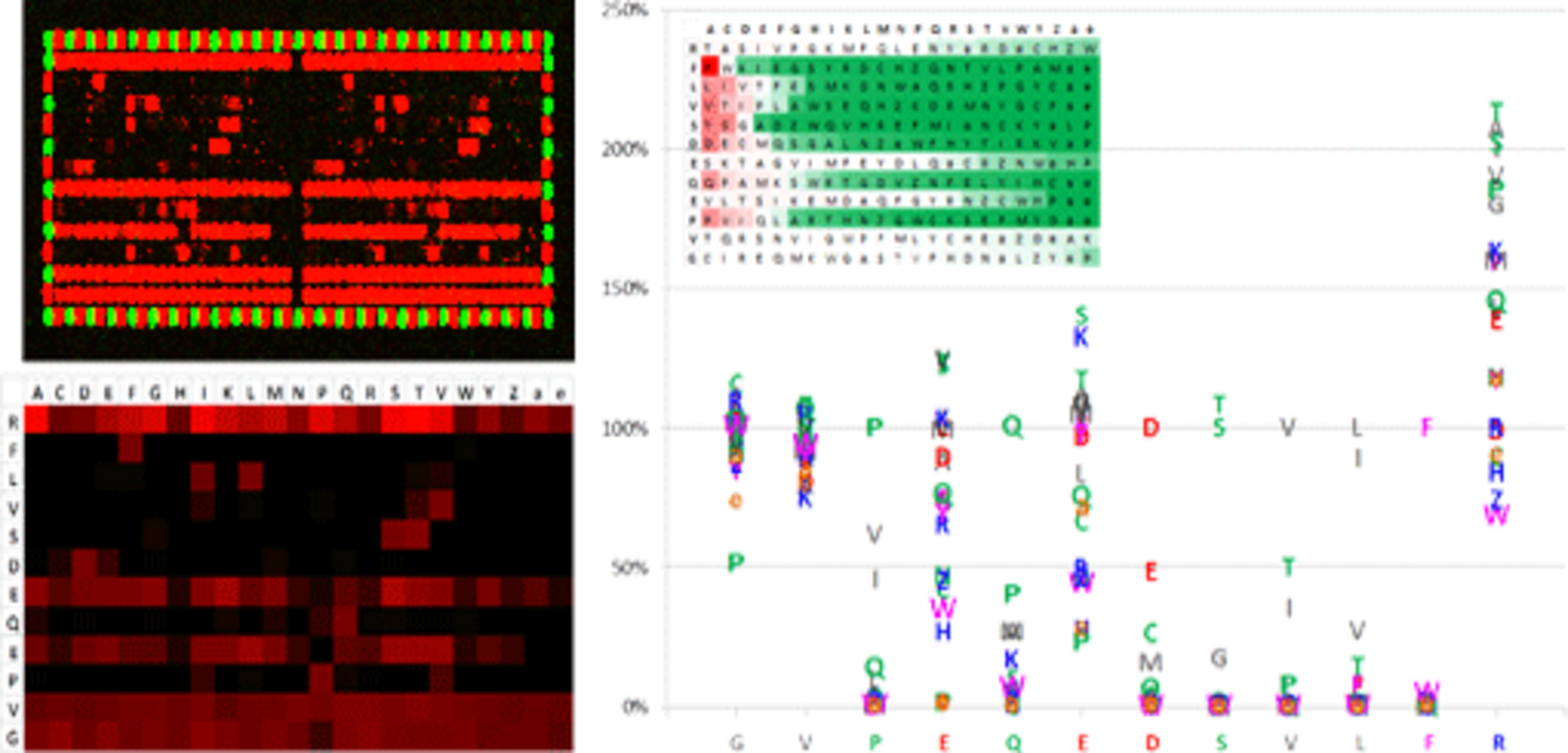Epitope Substitution Scan
Go beyond epitope identification
Once you have identified the epitope of an antibody, the next step is to further characterize its binding sites to gain deeper insights and enhance its applications. Further characterization is beneficial for many reasons:
- Identify conserved and variable amino acid positions
Understanding which amino acids in an epitope are crucial for antibody binding helps in delineating the conserved and variable positions. This information is vital for designing safer and more effective antibodies and therapeutics. - Discover epitope variants and mimotopes
Identifying epitope variants and mimotopes (peptides that mimic the structure of an epitope) can aid in vaccine development and in creating peptide-based therapeutics. - Optimize binding efficiency
In protein or peptide therapeutics developent, optimizing binding efficiency is critical. Fine-tuning the epitope supports the rational design of more potent and specific therapeutics. - Enhance diagnostic tools
Detailed epitope characterization can improve the specificity and sensitivity of diagnostic assays, leading to more accurate diagnostics. - Strengthen intellectual property protection
Comprehensive epitope characterization can provide robust data for patent applications, enhancing the protection of intellectual property.
More than just an alanine scan
The classic technique of alanine scanning involves systematically substituting each amino acid in an epitope with alanine to identify the critical residues for binding. While useful, this method has limitations as it only substitutes with one amino acid, providing a limited view of the epitope's structural requirements. Full epitope substitution scans are possible with PEPperCHIP® Peptide Microarrays, thanks to our platform technology which enables the cost-efficient stepwise substitution of all amino acid positions of a given epitope or peptide with all 20 standard, or additional non-natural amino acids.
Advantages of Epitope Substitution Scans with PEPperCHIP® Peptide Microarrays
- Comprehensive Substitution: Unlike traditional alanine scans, our method provides a complete substitution profile, revealing how each possible amino acid affects binding.
- High-throughput Analysis: Our peptide microarray technology allows for simultaneous analysis of multiple substitutions, making the process efficient and cost-effective.
- Detailed Insights: Gain a nuanced understanding of the epitope, identifying both critical and tolerated substitutions, which can inform the development of optimized antibodies and therapeutics.

Epitope Substitution Scan of a 12 amino acid starting peptide printed in duplicate. The microarray scan (top left) shows a typical exchange pattern that is translated into a heat map (bottom left). The amino acid plot highlights the change in spot intensities upon amino acid exchange with the wild type epitope at 100%. Seven out of 12 amino acids are highly conserved with a limited tolerance for exchange. Stained HA (red) and Flag (green) control peptides frame the single substitution of the starting peptide.
| Single Substitution Scan | Double Substitution Scan | |
| Microarray format | PEPperCHIP® Standard Microarray | PEPperCHIP® Discovery Microarray |
| Microarray content | Gradual exchange of all amino acid positions with all amino acids | Gradual exchange of all amino acid positions with all amino acids |
| Amino acids | 20 main amino acids by default, additional non-natural amino acids on demand | 20 main amino acids by default, additional non-natural amino acids on demand |
| Peptide length | Up to 15 amino acids by default (adjustable) | Up to 15 amino acids by default (adjustable) |
| Motif length for scan | Up to 14 amino acids by default (adjustable) | Up to 11 amino acids by default (adjustable) |
| Peptide replicates | Triple spots by default (adjustable) | Double spots by default (adjustable) |
| Control peptides | HA (YPYDVPDYAG) epitopes by default | HA (YPYDVPDYAG) epitopes by default |
| Example | A 12 amino acid starting peptide will be translated into 12 x 20 = 240 peptides printed in triplicate | An 11 amino acid starting peptide will be translated into 26,400 different peptides printed in duplicate |
| Input data | Starting epitope or peptide sequence of up to 15 amino acids | Starting epitope or peptide sequence of up to 15 amino acids |
| Sample material | 10-20 µl serum or 10-20 µg purified antibody | 100 µl serum or 100 µg purified antibody |
| Analysis | DIY following the PEPperCHIP® Immunoassay Protocol, or by PEPperMAP® Service | Available by PEPperMAP® Service only |
Epitope substitution scan use cases
Further characterization of known epitopes through an epitope substitution scan provides invaluable insights into antibody binding sites, aiding in the development of optimized therapeutics, improved diagnostics, and robust intellectual property protection. Learn how epitope substitution scans with PEPperCHIP® Peptide Microarrays can accelerate your research by exploring some of our selected case studies and customer publications.
Application notes
- Characterization of an anti-CD20 antibody by conformational epitope mapping and epitope substitution scan
- Antibody validation with a combination of protein and peptide microarrays
- Substitution scan of HA and M13 epitopes by PEPperCHIP® Peptide Microarrays
Cited publications
- Diverse Murine Vaccinations Reveal Distinct Antibody Classes to Target Fusion Peptide and Variation in Peptide Length to Improve HIV Neutralization (Sastry et al. 2023)
- Circulating galectin-1 delineates response to bevacizumab in melanoma patients and reprograms endothelial cell biology (Bannoud et al. 2023)
- A Protein Epitope Targeted by the Antibody Response to Kawasaki Disease (Rowley et al. 2020)

